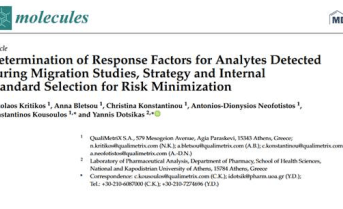We are thrilled to announce an exciting development in our field that addresses key challenges and reshapes the landscape of E&L studies. Our latest peer-reviewed publication, titled “Determination of Response Factors for Analytes Detected during Migration Studies, Strategy and Internal Standard Selection for Risk Minimization" is a remarkable milestone in our ongoing journey to upgrade the dependability of E&L studies as a tool for assessing the safety of pharmaceutical products. This research not only reinforces our commitment to innovation but also enhances the quality of services we provide to better serve our customers and partners.
Let's dive into the key highlights and how it relates to our offerings:
The two main aspects that are crucial for conducting a compatibility assessment are the detected species identity, since chemical structure is linked with biological activity, including toxicity and concentration, as the magnitude of any biological effect is directly related to the patient’s exposure. Of course, not every species eliciting a response needs to be addressed in terms of its safety impact but only those exceeding a dose-based threshold (DBT) in order to cover for both carcinogenic and non-carcinogenic effects. In order for the DBT to be meaningful from an analytical perspective, a conversion to a concentration-based threshold is necessary. The latter, know as the Analytical Evaluation Threshold (AET) defines the level below which the analyst needs not identify or quantify leachables or extractables and report them for toxicological assessment.
The quantitation exercise in the frame of an analytical screening or targeted screening method is a two-step process. The aim of the first step (i.e. preliminary quantitation) is to conclude on the species that need to be further processed and identified while the second step focuses on providing a more accurate quantitative estimate. A commonly employed strategy is that of a surrogate standard that is used to normalize the responses obtained for the detected species and estimate their concentration in the test sample.
This approach, however is based on the simplifying assumption that all analytes respond similarly among themselves and with respect to the surrogate standard. Unfortunately, this is far from the actual reality since the analytical response significantly varies across the universe of the chemically diverse E&L compounds. A consequence of this variation is that the AET becomes potentially less “protective” for compounds with low response factors considering that these would be falsely estimated to lie below the AET and therefore not reported and submitted to the toxicological evaluation process.
The PQRI suggests the application of uncertainty factors to limit the risk of potential analytes detected escaping report and further evaluation; however, whether the application of a default value can cover any or all relevant applications is still debatable. The current study evaluates the response of species usually detected in migration studies and suggests a strategy and evaluation mechanism for a sufficiently “protective” and acceptable classification of the detected species below or above the AET.
To access the publication and explore the full scope of its implications, please follow the link below.
https://www.ncbi.nlm.nih.gov/pmc/articles/PMC10421053/pdf/molecules-28-05772.pdf

